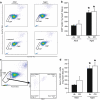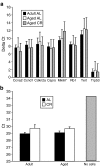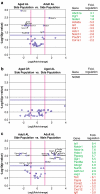Caloric restriction does not alter effects of aging in cardiac side population cells
- PMID: 20922487
- PMCID: PMC3168602
- DOI: 10.1007/s11357-010-9188-y
Caloric restriction does not alter effects of aging in cardiac side population cells
Abstract
The aged heart displays a loss of cardiomyocyte number and function, possibly due to the senescence and decreased regenerative potential that has been observed in some cardiac progenitor cells. An important cardiac progenitor that has not been studied in the context of aging is the cardiac side population (CSP) cell. To address this, flow cytometry-assisted cell sorting was used to isolate CSP cells from adult (6-10 months old) and aged (24-32 months old) C57Bl/6 mice that were fed either a control diet or an anti-aging diet (caloric restriction, CR). Aging caused a 2.3-fold increase in the total number of CSP cells and a 3.2-fold increase in the cardiomyogenic sca1(+)/CD31(-) subpopulation. Aging did not affect markers of proliferation or senescence, including telomerase activity and expression of cell cycle genes, in sca1(+)/CD31(-) CSP cells. In contrast, the aged cells had reduced expression of genes associated with differentiation, including smooth muscle actin and cardiac muscle actin (5.1- and 3.2-fold, respectively). None of these age effects were altered by CR diet. Therefore, it appears that the manner in which CSP cells age is distinct from the aging of post-mitotic tissue (and perhaps other progenitor cells) that can often be attenuated by CR.
Figures



Similar articles
-
Proliferation, differentiation and migration of SCA1-/CD31- cardiac side population cells in vitro and in vivo.Int J Cardiol. 2017 Jan 15;227:378-386. doi: 10.1016/j.ijcard.2016.11.047. Epub 2016 Nov 9. Int J Cardiol. 2017. PMID: 27847151
-
Desmin deficiency affects the microenvironment of the cardiac side population and Sca1+ stem cell population of the adult heart and impairs their cardiomyogenic commitment.Cell Tissue Res. 2022 Aug;389(2):309-326. doi: 10.1007/s00441-022-03643-8. Epub 2022 Jun 4. Cell Tissue Res. 2022. PMID: 35661920
-
Caloric restriction attenuates the age-associated increase of adipose-derived stem cells but further reduces their proliferative capacity.Age (Dordr). 2011 Jun;33(2):107-18. doi: 10.1007/s11357-010-9166-4. Epub 2010 Jul 14. Age (Dordr). 2011. PMID: 20628827 Free PMC article.
-
Caloric restriction maintains stem cells through niche and regulates stem cell aging.J Mol Med (Berl). 2020 Jan;98(1):25-37. doi: 10.1007/s00109-019-01846-1. Epub 2019 Nov 12. J Mol Med (Berl). 2020. PMID: 31713638 Review.
-
Caloric restriction and cellular senescence.Mech Ageing Dev. 2018 Dec;176:19-23. doi: 10.1016/j.mad.2018.10.005. Epub 2018 Nov 3. Mech Ageing Dev. 2018. PMID: 30395873 Review.
Cited by
-
Effects of caloric overload before caloric restriction in the murine heart.Aging (Albany NY). 2022 Mar 28;14(6):2695-2719. doi: 10.18632/aging.203967. Epub 2022 Mar 28. Aging (Albany NY). 2022. PMID: 35347086 Free PMC article.
-
Proteomic analysis of proteins associated with cellular senescence by calorie restriction in mesenchymal stem cells.In Vitro Cell Dev Biol Anim. 2012 Mar;48(3):186-95. doi: 10.1007/s11626-012-9485-0. In Vitro Cell Dev Biol Anim. 2012. PMID: 22314686
-
The Role of Cardiac Side Population Cells in Cardiac Regeneration.Front Cell Dev Biol. 2016 Sep 13;4:102. doi: 10.3389/fcell.2016.00102. eCollection 2016. Front Cell Dev Biol. 2016. PMID: 27679798 Free PMC article. Review.
References
-
- Baba S, Heike T, Yoshimoto M, Umeda K, Doi H, Iwasa T, Lin X, Matsuoka S, Komeda M, Nakahata T. Flk1(+) cardiac stem/progenitor cells derived from embryonic stem cells improve cardiac function in a dilated cardiomyopathy mouse model. Cardiovasc Res. 2007;76:119–131. doi: 10.1016/j.cardiores.2007.05.013. - DOI - PubMed
-
- Chimenti C, Kajstura J, Torella D, Urbanek K, Heleniak H, Colussi C, Meglio F, Nadal-Ginard B, Frustaci A, Leri A, Maseri A, Anversa P. Senescence and death of primitive cells and myocytes lead to premature cardiac aging and heart failure. Circ Res. 2003;93:604–613. doi: 10.1161/01.RES.0000093985.76901.AF. - DOI - PubMed
Publication types
MeSH terms
Grants and funding
LinkOut - more resources
Full Text Sources
Medical
